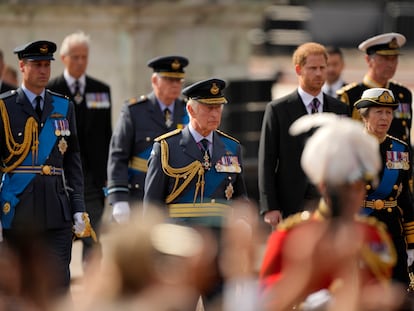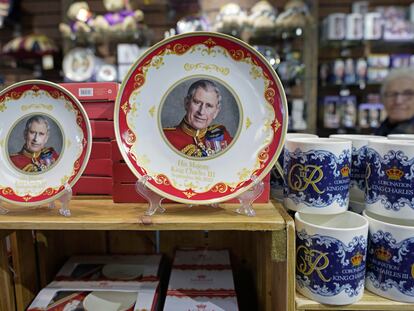Charles III, the king of flowers
The British monarch’s obsession with botany will be widely reflected in his coronation
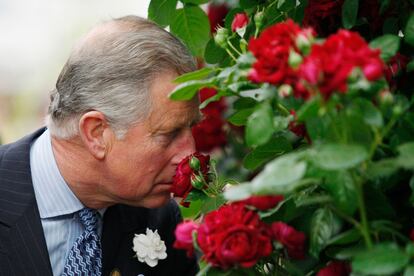
In the fourth season of The Crown, the former Prince of Wales strolls around the grounds of Highgrove House, with his mother, the late Queen, and tells her he’s thinking of a wild garden here, a kitchen garden there, a sundial garden over there. “Everything will be organic, no pesticides, and no straight lines,” he tells her. “Nothing too neat or uniform,” he adds. It will have “a certain wild unconventionality.”
It is not known how much of this conversation really happened at the Gloucester mansion that has been Charles’ family residence since 1980. But what is certain is that it accurately reflects one of the most fundamental aspects of Britain’s new King: his passion for botany.
Scepter, crown and pruning shears
More than 40 years after planting his first seedling — perhaps his favorite Delphinium elatum — in the gardens of Highgrove House, the eternal heir-turned-King celebrates his coronation this week. Saturday, May 6, will effectively be the crowning moment of Charles’ life as a royal, an event for which he has been preparing since the age of three. And, inevitably, the “wonderful and therapeutic” world of plants, as Charles himself describes it, will play a key role in the proceedings.
The King’s commitment to ecology and environmental protection will also be evident in every detail of the coronation as designers, protocol teams, National Heritage technicians, stylists, historians and national florists’ associations have worked on the scenography of the solemn event in a bid to bring out the symbolic aspect of the plants.
The invitation that went out to 2,000 guests is printed on recycled cardboard. The work of the heraldry artist Andrew Jamieson, it includes an ornamental design drawn by hand in watercolors depicting a fertile natural universe with flowers, herbs, butterflies, insects, birds and fruits. It also features the leafy-faced Green Man, a figure from British folklore that symbolizes the rebirth of spring. Around him, amidst a jumble of bluebells, cornflowers, wild strawberries, lily of the valley, oak leaves, rose hips, acorns, rosemary in bloom and other British meadow flowers, the design features the U.K.’s four national flowers: the Welsh daffodil, the Scottish thistle, the Irish shamrock, and the English rose.
These four flowers are also woven into the logo to commemorate the royal event, an emblem designed by Sir Jony Ive, a visionary who worked at Apple and was one of the architects behind the design of the iPhone, iPad and Apple Watch.
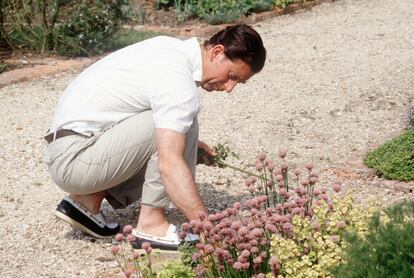
Flowers en route
But the flower motif is not confined to the invitations. It will be threaded throughout each of the scenes to unfold in London on May 6 that will be watched by millions around the world. Indeed, flowers will highlight important focal points at Westminster Abbey, Buckingham Palace and on the motorcade route between the two venues.
“The floral designs are based on thorough research on plant species and colors of the Royal House,” said Cristian von Knobloch, from Flores Búcaro, the florist responsible for the flowers at the wedding of Spanish King Felipe and Letizia Ortiz in Madrid, the wedding of the Infanta Elena and Jaime de Marichalar in Seville and of several members of the House of Alba. “A grand palace staircase will always look better if side tables in the banquet hall are decorated. The specialists take great care to make the flowers enhance the tableware, glassware and heirlooms that dress the tables.”
Ranunculus, peonies and roses from the Highgrove House garden.
It is not surprising that the florists hired by the British royal household will be sourcing from Charles III’s own gardens on the eve of the coronation for their plant ornaments, centerpieces, bouquets and all the creations that will adorn Westminster Abbey and Buckingham Palace, where the banquet will be served following the ceremony. And where better to source fresh pelargoniums, scabious, dahlias, ranunculus, English garden roses, peonies, aquilegias, apricot-colored geums, astilbes, lilacs, muguet, hydrangeas, tulips, English oak scions, myrtle branches and other local greens than the gardens of Clarence House in London and Highgrove House. The almost zero-kilometer sourcing also addresses Charles’ concern over climate change. “We are sure that the flowers will be from the gardens of his own palaces or from the English countryside to avoid air transport and to promote the local economy by using local raw materials,” Von Knobloch added.
“We expect laurel to be present, as it is the species par excellence in the coronation of heroes since antiquity,” said Marta Gallego, landscape designer and professor of Historic Gardens at the Castillo de Batres Landscape School in Madrid. “Also, rosemary, which symbolizes remembrance, indicating that Charles III will not forget the legacy of previous monarchs. And who knows, there might be exotic species from the countries that make up the Commonwealth, aside from the rose, which is the symbol of the Tudors and the prized flower in British gardening. The very wide variety of modern roses that we know today is the result of research by English horticulturists,” she added.
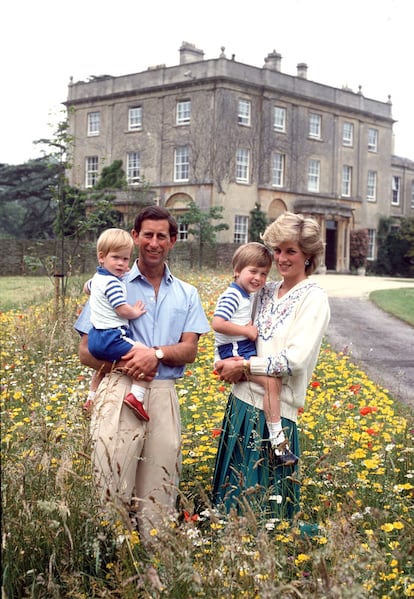
The flowers are not only being chosen for their beauty, but also for what they represent. “White symbolizes purity; blue, royalty; and the colors of the national flag will certainly be present,” explained Von Knobloch. “In these turbulent times for European monarchies it is more important than ever to be able to convey the pomp of these age-old rites (power, elegance, solemnity and a certain divinity) while adapting to the times: without opulence, without arrogance and with nods to all the members of the Commonwealth,” he added.
In the post-pandemic period, less is more. “As a florist, I would give visual unity to the religious ceremony, the palace gate and the key points of the circuit with large XXL flower arrangements. Without sacrificing the spectacular aspect, but without unnecessary waste and with an ecological awareness,” he said.
Lilies of the valley in memory of Queen Elizabeth II
It is well known that flowers have their own language, with each species conveying a message. “The main connotation should be that of the quiet renewal of the institution,” said Gallego. “Charles III will continue the legacy of his mother, seeking to carry out the role in the same impeccable way, but with a fresh touch.” Devotion, spiritual purity, good will, duty to service, protection, gratitude, loyalty, desire for rebirth, family duty, the strength of love and a message of joy after the long period of mourning for Elizabeth II are among the messages that could be conveyed by the floral arrangements to adorn London. “The plant language is the highest and oldest in history, the most loaded with symbolism and also the most universal,” Gallego added. “Those who know the symbolism of the species will decipher what King Charles III wants to tell us. The rest of us will simply delight in the beauty of the flowers, their perfection, color and aroma.”

“I think I can be happy here,” Charles tells his mother during the aforementioned episode of The Crown at Highgrove. “My little Shangri-La or Xanadu,” he says before quoting a few lines from Samuel Taylor Coleridge’s poem Kubla Khan: “And there were gardens bright with sinuous rills, Where blossomed many an incense-bearing tree; And here were forests ancient as the hills, Enfolding sunny spots of greenery.”
Sign up for our weekly newsletter to get more English-language news coverage from EL PAÍS USA Edition
Tu suscripción se está usando en otro dispositivo
¿Quieres añadir otro usuario a tu suscripción?
Si continúas leyendo en este dispositivo, no se podrá leer en el otro.
FlechaTu suscripción se está usando en otro dispositivo y solo puedes acceder a EL PAÍS desde un dispositivo a la vez.
Si quieres compartir tu cuenta, cambia tu suscripción a la modalidad Premium, así podrás añadir otro usuario. Cada uno accederá con su propia cuenta de email, lo que os permitirá personalizar vuestra experiencia en EL PAÍS.
¿Tienes una suscripción de empresa? Accede aquí para contratar más cuentas.
En el caso de no saber quién está usando tu cuenta, te recomendamos cambiar tu contraseña aquí.
Si decides continuar compartiendo tu cuenta, este mensaje se mostrará en tu dispositivo y en el de la otra persona que está usando tu cuenta de forma indefinida, afectando a tu experiencia de lectura. Puedes consultar aquí los términos y condiciones de la suscripción digital.
More information
Últimas noticias
Most viewed
- Sinaloa Cartel war is taking its toll on Los Chapitos
- Oona Chaplin: ‘I told James Cameron that I was living in a treehouse and starting a permaculture project with a friend’
- Reinhard Genzel, Nobel laureate in physics: ‘One-minute videos will never give you the truth’
- Why the price of coffee has skyrocketed: from Brazilian plantations to specialty coffee houses
- Silver prices are going crazy: This is what’s fueling the rally
